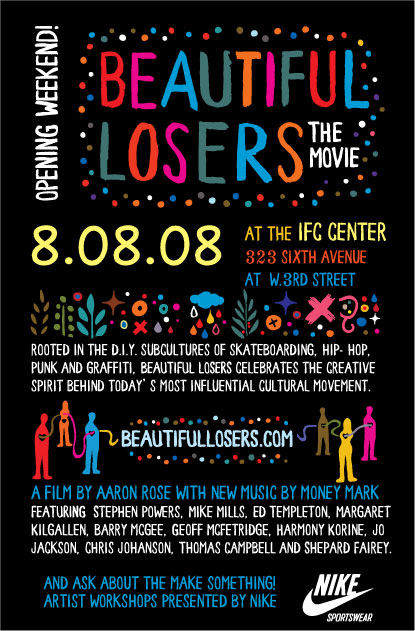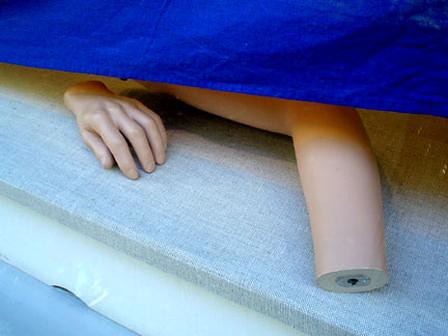 An unexpected bonus of the whole Buying In thing has been getting introduced to interesting online book-related projects. I mentioned Seen Reading in an earlier post. More recently I got a note inviting me to participate in The Page 99 Test, which was inspired by Ford Madox Ford’s assertion: “”Open the book to page ninety-nine and read, and the quality of the whole will be revealed to you.” Here’s my bit.
An unexpected bonus of the whole Buying In thing has been getting introduced to interesting online book-related projects. I mentioned Seen Reading in an earlier post. More recently I got a note inviting me to participate in The Page 99 Test, which was inspired by Ford Madox Ford’s assertion: “”Open the book to page ninety-nine and read, and the quality of the whole will be revealed to you.” Here’s my bit.
 AntiPod
AntiPod
Are Zune buyers motivated by what the device is – or what it isn’t?
Today in Consumed: Who chooses to buy a Zune, and why? The marketing of the device has stressed its “social” features. But is that really the attraction?
Community and togetherness seem like a reasonable counterpunch to iPod’s supposed attraction as an individuality enabler that allows owners to wallow in their own tasteful personal soundtracks. But in real life, the cafe patron checking for other Zune owners is less likely to find one than to arouse mild curiosity about his eccentric product choice. Meanwhile, owning an iPod seems roughly as individualistic as a gray flannel suit.
Read the column in the August 10, 2008, issue of The New York Times Magazine, or here.
Consumed archive is here, and FAQ is here. Consumed Facebook page is here.

I’m happy that the Beautiful Losers documentary is getting plenty of attention, and I look forward to seeing it. I’m a fan of many of the artists who I gather are in it, and I both like and respect Aaron Rose. He is interviewed in the current issue of Complex talking about a spinoff project: “Make Something!! Workshops,” and I like the sound of these, too. The film’s site says:
Working with public school art programs and youth mentoring programs, MAKE SOMETHING!! will invite local children to participate in creative workshops such as sign painting, photography, skateboard graphic design, toy design, filmmaking, tattoo art, footwear design and zine making.
Workshops will be hosted by renowned artists from the Beautiful Losers “do-it-yourself” art subculture, which include Ed Templeton, Tobin Yelland, Geoff McFetridge, Shepard Fairey, Mike Mills, Todd James, Cheryl Dunn, Kaws, Mr. Cartoon and Aaron Rose. The work created in each location will form a continually evolving exhibition, which will be open to the public to view.
Sounds good.
And yet … despite all my good vibes about this … I must say that my reaction to the version of the movie poster above was: What’s the swoosh doing on there?
These workshops, apparently, are courtesy of Nike. Was that really necessary? “Make something” is obviously a fine message — but to me the whole idea of doing-it-yourself kind of loses its oomph if the doing has to happen under the auspices of the almighty swoosh. After all, did the various artists and creators celebrated in the film have to rely on a multinational to learn to express themselves? I think not. On the film’s site, the tab for this project is simply “Nike Workshops.” Ew.
I think this a bad move on Nike’s part — if Swoosh Inc. wants to do something good for the kids, then just do it (to borrow a phrase) and for once keep your logo to yourself.
I also just think it’s, you know, a general all-around bummer.
Not that any of this will stop me from seeing the doc. In fact I wish I could make it to the U.S. premier, in New York City, tonight.
Well it’s AntiFriday again, and time for a rundown of the latest in dissent, backlashing, critiques, and like that.
 1. On The Point website, someone has started a campaign titled: “Bono — Retire from public life and we’ll donate a ton of money to fight AIDS.” Partly it’s an anti-Product Red effort, but really it’s about hating Bono. The “Pitch,” in part:
1. On The Point website, someone has started a campaign titled: “Bono — Retire from public life and we’ll donate a ton of money to fight AIDS.” Partly it’s an anti-Product Red effort, but really it’s about hating Bono. The “Pitch,” in part:
Bono’s philanthropy efforts are self-righteous, ineffective, & counter-productive….
The grassroots leaders of the global fight against AIDS didn’t ask for Bono to be their frontman. Its time for Bono to step down. We’ll all pledge donations to the Global Fund, but no pledges are collected until Bono retires from public life…
As I type, $1,108 have been pledged.
This item via WFMU’s Beware of The Blog, where Bono was previously assaulted here.
2. The Oregonian reports that a Converse effort to put up street-art-style ads on some buildings on Portland’s North Alberta Street has ended poorly. Somebody called the cops, but that’s not really the bad part.
The vacant building’s owner, developer Rambo Halpern, said he wouldn’t have granted permission to Nike-owned Converse to post the ads had he been asked. Alberta Street, he noted, is known as an art district and alternative business hub.
“They’re a little bit anti-corporate, anti-chain,” Halpern said. “Providing free advertising to a corporation making billions of dollars a year is not high on my list of priorities.”
Ouch! Not exactly the reaction Converse wants, I’d say. (Actually, I did say it, to reporter Brent Hunsberger. I’m quoted in this article. Just so you know.)
Related, on Public Ad Campaign blog: Converse subway ad subverted in NYC.
3. Steve Powers offers this:

Enamel on aluminum; $1,999; here.
If you missed Powers’ most recent project, here’s a Times article by Ariel Kaminer, about the “Waterboard Thrill Ride.”
More AntiFriday after the jump. Please continue…
As we know, not everybody sees Obama as the antichrist. So here’s a more prObama bit of news following up on the subject of the candidate as muse (per April 13, 2008 Consumed):
The Obey blog announces Manifest Hope:
It’s a new Obama art contest for 2D and 3D art, from painting to photography to sculpture. The winners will be shown at the Manifest Hope Gallery online and in Denver during the Democratic convention alongside works from dozens of established and influential artists.
And, via this meditation in The Stranger on the Obama-as-muse phenomenon, I am now aware of a blog dedicated to the subject: The Obama Art Report. Worth a look.
Not sure if there’s any scripture linking the rapture to art, design, and stylish product, but if so — oh, never mind.
This Wall Street Journal article sums up the “controversy” over a McCain Web ad (on YouTube, here) that some say suggests Obama is not just aloof and full of himself and naive … he’s the antichrist! A highlight is expert commentary from Left Behind * co-author Tim LaHaye:
[He] said in an interview that he recognized allusions to his work in the ad but comparisons between Sen. Obama and the antichrist are incorrect.
“The antichrist isn’t going to be an American, so it can’t possibly be Obama. The Bible makes it clear he will be from an obscure place, like Romania.”
The story also notes that “suggestions that Sen. Obama is the antichrist have been circulating for months in Bible-study meetings” in some towns, and also that the ad’s imagery is suggestive in ways that will be obvious to anyone versed in what an expert calls “apocalyptic popular culture.”
I’m hoping that this draws a Paris Hilton-style response video from the actual antichrist.
UPDATE: Here is barackobamaantichrist.blogspot.com. “Hello. You have stumbled upon this site by searching ‘Barack Obama Antichrist’ which was in the back of your mind, you were curious if anyone else had thought about it, so you gave it a google. Welcome. You are not alone, explore the site.” Be sure to view the poll results. [Thx to extra-special adviser E for that.]
[If you’re not a big apocalyptic pop culture follower, Left Behind was discussed in the November 13, 2005 Consumed.]
Thanks to all who came out to Politics & Prose last night (and to Becca and Mike), a good time was had by, if not all, than certainly most.
I’m traveling home today and will again be a little too distracted to do much here on Murketing.com, but wanted to pass one thing along as a follow-up to last Sunday’s KAWS column. In that column I mentioned Edward Winkleman’s blog* as a source of reasonable and clear discussion of the too-often mystifying art gallery world. He’s posted a good set of additional thoughts about artists going solo vs. working with a gallery. Check out the whole thing, but here’s a snippet: In addition to the marketplace motivations I mentioned, a gallery show can
perhaps most importantly, provide a context in which not only solo exhibitions can garner press but an artist’s work can be supported against bad press or misunderstandings on the part of the public. The program at most contemporary art galleries is an ongoing dialog about what’s important in today’s art world. Within that context, an artist can perhaps afford to take some risks that wouldn’t make sense without an exhibition space dedicated to their latest ideas, get feedback on them, and return the studio to hammer them out. I’m not sure that’s as possible in museums or other exhibition spaces as it is in many galleries. Yes, I know, the general meme is that galleries are often worse because they’ll only exhibit what they know they can sell. I think that describes a small percentage of the galleries most of us would consider good ones though.
[* PS: thanks to E for tipping me off to Winkleman’s blog in the first place.]
I was pleased to see somebody pick up on the Andrew Andrew stuff at the end of Buying In, and relate it to magical thinking. That post, on the Psychology Today blog of Matthew Hutson, led me to his article on the subject of magical thinking. Since I’m away from home and I’m going to be a little busy today, I point you to that article if you’re looking for something to read. It may be a bit long to read online, but here’s one bit of interest relating to magical thinking and material culture:
To some, John Lennon’s piano is sacred. Most married people consider their wedding rings sacred. Kids with no notion of sanctity will bust a lung wailing over their lost blanky. Personal investment in inanimate objects might delicately be called sentimentality, but what else is it if not magical thinking? There’s some invisible meaning attached to these things: an essence. A wedding ring or a childhood blanket could be replaced by identical or near-identical ones, but those impostors just wouldn’t be the same.
What makes something sacred is not its material makeup but its unique history. And whatever causes us to value essence over appearance becomes apparent at an early age. Psychologists Bruce Hood at Bristol University and Paul Bloom at Yale convinced kids ages 3 to 6 that they’d constructed a “copying machine.” The kids were fine taking home a copy of a piece of precious metal produced by the machine, but not so with a clone of one of Queen Elizabeth II’s spoons—they wanted the original.
A Freakonomics Quorum offers various answers to the question “What happened to boxing’s Golden Age?” One participant says:
It’s also a brutally honest sport despite the presence of pageantry. I wonder if the American audience in this current day and age wants to deal with something as raw as the sweet science.
Having spent some time in the last few days following this post learning about how popular “mixed martial arts” (ultimate fighting) is, and how brutal, I’m not so sure about this theory. Maybe that earlier post actually offers another answer: boxing’s problem is the lack of associated fashion brands!

I enjoy looking at ffffound, but sometimes I wish there was a little more information. I love this, but the link just goes here. I poked around gigposters but I guess I’m too click-incompetent and can’t figure out who this artist is.
Do you know?
Thanks to Rich (see comment below) I now know this is the work of StrawberryLuna, a designer and screenprinter in Pittsburgh. This print is called “fair is fair trade,” three colors. 16X22, edition of 90, $25. More prints here, posters here, design here. Nice!
Big thanks to Rich, both for finding, and for not mocking my sad lack of gigposter-navigations skills.
 New Looks
New Looks
An established art entrepreneur makes his way into a new realm — the art world.
This week in Consumed, Brian Donnelly, a/k/a KAWS, and the relationship between art, markets, and value.
At 33, Brian Donnelly is enjoying a successful art career. Working out of a studio in Brooklyn, he has sold paintings to Pharrell Williams, the rapper and producer; Nigo, the designer-entrepreneur; and Takashi Murakami, the international art star, among others. He has also created a variety of products including toys, apparel and even pillows — and indeed he has his own store, Original Fake, in Tokyo. He has also been widely known in the “street art” world for years; one of his early altered-phone-booth-ad posters recently traded hands on eBay for $22,000. One thing Donnelly had not done until lately, however, is forge a relationship with a dealer or art gallery. This wasn’t because he shunned or had a problem with the traditional gallery system. He says it’s just that “nobody asked.”
[Now he has a bunch of gallery shows and relationship with a gallerist who] figures there’s another market for his work. “I think it needs to get out there in the art world,” she says.
Read the whole column in the August 3, 2008, issue of The New York Times Magazine, or right here.
Additional links*: KAWS site; Donnelly’s blog; Edward Winkleman’s blog; John Jay’s blog; Gering & López Gallery site.
Consumed archive is here, and FAQ is here. Consumed Facebook page is here.
[*QUESTION: I used to do this “additional links” thing all the time, then I stopped. Is it useful? Do you want it? Please let me know.]
 An unexpected bonus of the whole Buying In thing has been getting introduced to interesting online book-related projects. I mentioned Seen Reading in an earlier post. More recently I got a note inviting me to participate in The Page 99 Test, which was inspired by Ford Madox Ford’s assertion: “”Open the book to page ninety-nine and read, and the quality of the whole will be revealed to you.” Here’s my bit.
An unexpected bonus of the whole Buying In thing has been getting introduced to interesting online book-related projects. I mentioned Seen Reading in an earlier post. More recently I got a note inviting me to participate in The Page 99 Test, which was inspired by Ford Madox Ford’s assertion: “”Open the book to page ninety-nine and read, and the quality of the whole will be revealed to you.” Here’s my bit.



 "
"
 AntiPod
AntiPod


















 Kim Fellner's book
Kim Fellner's book  A
A